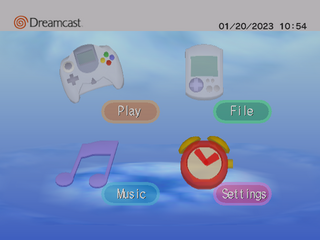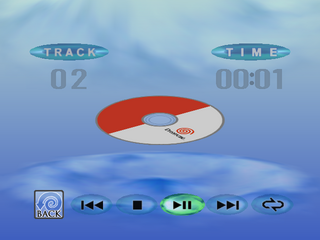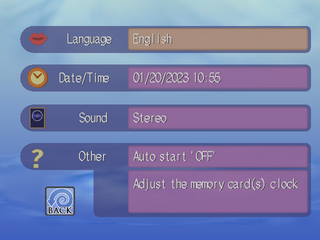Sega Dreamcast/Boot ROM
From Sega Retro
- Back to: Sega Dreamcast.
All variants of the Sega Dreamcast come pre-installed with a boot ROM - an interface which appears when the console is given power. GD-ROMs and CD-ROMs require time for verification and loading, which depending on the quality of the disc or drive, can take several seconds. The boot ROM manages this, while also informing the user that the console is working. It fulfils the same function as seen with the Sega Saturn's boot ROM.
Usually, if the console detects and verifies a disc, the Dreamcast boot ROM is limited to an introduction and jingle, after which the game loads. Should a compatible Dreamcast disc not be detected (detection also requires the console's lid to be closed, as the disc will not spin otherwise), the user is taken to a menu. If the console's lid has been left open when powering on the console, the logo animation is skipped.
Contents
Menu
The Dreamcast's menu is much the same as the Sega Saturn's, allowing users to play music CDs, adjust the contents of VMUs and configure global settings such as the system's time and language. The Dreamcast will prompt the user to set the time on boot up if the clock battery is non-functional. There is also an option to force the Dreamcast to boot into this menu, rather than straight into the game.
The "File" option allows users to manage the contents of their memory cards, however a full reset of a card allows for colour and icon customisation (which is only seen on this screen). The stored time on each VMU can be syncronised with the Dreamcast's clock through the "Settings" menu.
While the Saturn perhaps over-compensates in terms of audio features, the Dreamcast has a very simple CD player. Rather than any elaborate visualisations when playing, the user simply sees a 3D spinning disc, however, if a Dreamcast game has a CD soundtrack and an appropriately named image on the disc, the console will render a virtual disc label.
Unlike the Saturn, whose language options only affected the boot ROM, Dreamcast language selection can affect games, and is available across all units. Supported languages include Japanese, English, French, German, Spanish and Italian (although some games are known to add more, such as Portuguese or Dutch). For the most part, only PAL games are likely to implement translations for each language, although it was also common to see specific-language builds of a game distributed in the relevant markets.
The menu design and functionality are the same across the world, however in PAL regions, red Dreamcast logos (and the back button) are either removed or switched to blue. In addition, NTSC-U Dreamcasts use a MM/DD/YYYY date scheme rather than DD/MM/YYYY.
Screenshots
License screen (Windows CE)
Hidden content
- Main article: Sega Dreamcast/Boot ROM/Hidden content.
Technical information
ROM dump status
| System | Hash | Size | Build Date | Source | Comments | |||||||||
|---|---|---|---|---|---|---|---|---|---|---|---|---|---|---|
| ? |
|
Dreamcast (JP) (v1.004) | MPR-21068 | |||||||||||
| ? |
|
Dreamcast (US) (v1.01d) | ||||||||||||
| ? |
|
Dreamcast (EU) (v1.01d) | ||||||||||||
| ? |
|
Dreamcast (JP) (v1.01d) | ||||||||||||
| ? |
|
Development kit (JP) (v1.011) | HKT-0120 |
References







